Are you looking for an unforgettable road trip experience that combines breathtaking natural beauty, fascinating history, and vibrant culture? Look no further than the High Road to Taos Scenic Byway, a 56-mile stretch of road that winds through the mountains and valleys of northern New Mexico.
This route, named for its winding path through the mountains rather than along the Rio Grande, takes travelers on a journey through traditional mountain communities and modern-day art enclaves, giving you a glimpse into the unique mix of lifestyles that make up this region.
What is High Road to Taos Scenic Byway?
The 56-mile (90-kilometer) High Road to Taos winds through the Sangre de Cristo Mountains between Santa Fe and Taos. It begins in Pojoaque, New Mexico, north of Santa Fe, at the intersection of US 285/84 and State Road 503. It continues to Nambé Pueblo via State Road 503. Nambé, which means “People of the Round Earth,” was founded in the 14th century.
The journey begins at the legendary Santuario in Chimayo, a popular destination for pilgrims and tourists alike. From there, the High Road cuts through the mountains, taking you through villages like Penasco, Cordova, and Truchas. These lush landscapes are home to families with histories tracing back dozens of generations and many artisans drawn to the area’s natural beauty.
History of the High Road to Taos Scenic Byway
The High Road to Taos Scenic Byway has a long and fascinating history that reflects the cultural diversity of northern New Mexico. The route was originally a trade route used by the Spanish colonizers to transport goods between Santa Fe and Taos. Over time, the road became an important artery for the communities that developed along it, linking them to each other and to the rest of the region.
Today, the High Road to Taos Scenic Byway is recognized as a National Scenic Byway, a designation that acknowledges it’s exceptional cultural, historic, and natural value. The road is maintained by the New Mexico Department of Transportation, which ensures that it remains safe and accessible to visitors year-round.
Starting Point: Santa Fe
The High Road to Taos Scenic Byway begins in the historic city of Santa Fe, which is located in the foothills of the Sangre de Cristo Mountains. Santa Fe is renowned for its rich cultural heritage and vibrant art scene, and there’s plenty to see and do here before you set out on your road trip.
Some of the top attractions in Santa Fe include the Georgia O’Keeffe Museum, which showcases the work of one of America’s most iconic artists, and the Palace of the Governors, a historic adobe building that has served as the seat of government for over 400 years. You can also explore the city’s many galleries, shops, and restaurants, which offer a taste of the region’s unique blend of Native American, Spanish, and Anglo cultures.
Nambe Pueblo Waterfalls
If you’re looking for a fun outdoor activity to add to your High Road to Taos itinerary, then a hike to the waterfalls at the Pueblo of Nambe is a great choice. Nambe Falls in New Mexico is a breathtaking natural wonder located in the Pueblo of Nambé, which is home to one of the six Tewa-speaking pueblos of Northern New Mexico.
The falls are situated in the foothills of the Sangre de Cristo Mountains, and cover nearly 20,000 acres of high desert landscape. The Pueblo opened the Nambé Falls Recreation Area in 1976 for visitors to enjoy camping, hiking and fishing, after a dam was built above the falls as part of the San Juan Chama project.
The recreation area offers two trails of approximately ¼ mile each, leading to the falls from the Ramada Area. One trail takes visitors up the hill for a spectacular view of the waterfalls from above, while the other trail goes along and through the river, leading to a beach area at the lowest pool. Visitors are advised to carry drinking water, wear water shoes, shorts, and a pack to hold their belongings, and to expect to get wet on the low trail. The Ranger Station offers water, soda, snacks, and ice for sale. The park is open for day use visitors until 6:00 pm, and visitors are required to exit by 6:30 pm, while campers must arrive before 7:00 pm.
Santuario de Chimayo – A spritual Oasis
As you leave Santa Fe and head north on the High Road to Taos Scenic Byway, your first main stop will be the village of Chimayo.
This popular destination is not only a stop for pilgrims making a journey of faith but also a must-see for any tourist hoping to capture the essence of New Mexico in a single photo frame. The immersion in the culture and beauty of New Mexico can be overwhelming, but the Santuario at Chimayo is an ideal starting point. This small village church, located in the foothills of the Sangre de Cristo Mountains, has been attracting pilgrims and visitors from around the world for centuries.
The chapel of the church, known as the “el pocito” (the little well), is a particularly special place. According to legend, the dirt on the chapel’s floor has healing properties and can cure illnesses and afflictions. Visitors can scoop up a handful of the dirt and take it with them as a souvenir, or apply it directly to any ailments they might have. The chapel is also home to a small well that is said to have miraculous properties.
Chimayo Church, also known as the Santuario de Chimayo, was built in the late 18th century by the Spanish settlers who came to New Mexico. The church was constructed on a site that was believed to be sacred by the native Tewa people, who used the area for religious ceremonies long before the arrival of the Spanish. The church’s location near the Santa Cruz River made it a popular stop for travelers and traders passing through the region.
Over time, Chimayo Church became known as a place of healing and spiritual renewal. The church’s walls were covered with ex-votos, small paintings, and offerings left by pilgrims who had been cured of illnesses or experienced other miracles while visiting the church. Today, the ex-votos are preserved in a small museum next to the church, which visitors can explore as part of their visit.
In addition to the Santuario, Chimayo is also known for its weaving traditions and its delicious cuisine. You can visit local weavers and see them at work, creating beautiful textiles using traditional methods. And when you’re hungry, be sure to try the local chile, which is renowned for its spicy, smoky flavor.
Truchas: Art, History, and Natural Beauty
Continuing on the High Road, your next stop will be the village of Truchas, which is perched on a high mesa overlooking the surrounding valleys and mountains. Truchas is home to many artists and writers, who are drawn to the area’s stunning natural beauty and rich cultural heritage.
One of the highlights of Truchas is the historic San José de Gracia church, which dates back to the early 18th century. This beautiful adobe structure is a testament to the region’s Spanish colonial heritage, and its elaborate interior decorations are a sight to behold.
Truchas is also a great place to explore the outdoors, with many hiking trails and scenic overlooks nearby. You can take a leisurely stroll along the Truchas Peak Trail, which offers stunning views of the surrounding mountains, or venture further afield to the nearby Pecos Wilderness.
Las Trampas: A Glimpse into the Past
Next on your journey along the High Road is the village of Las Trampas, which is home to another historic church, the San José de Gracia de Las Trampas. This church was built in the late 18th century and is considered one of the finest examples of Spanish colonial architecture in the region.
Las Trampas is also known for its many festivals and cultural events, which celebrate the village’s rich history and traditions. If you’re lucky enough to be in the area during one of these events, be sure to join in the fun and experience the local culture firsthand.
San Jose de Gracia
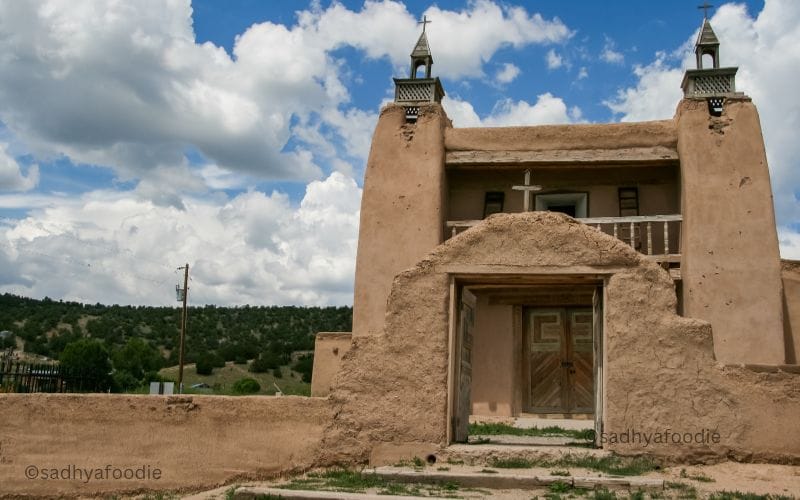
This iconic adobe-walled church is a popular stop along the High Road to Taos Scenic Byway, and it’s not hard to see why. The massive walls and intricate details of the church’s façade make it a favorite subject for both photographers and painters.
But the San Jose de Gracia Church isn’t just a pretty face – it’s also steeped in history and culture. The church was built in the early 1700s and has been a central part of the Ranchos de Taos community ever since. It has served as a place of worship, a gathering spot for community events, and a symbol of the area’s rich cultural heritage.
Ranchos de Taos: Art and Architecture
As you near the end of the High Road to Taos Scenic Byway, you’ll come to the village of Ranchos de Taos, which is home to another iconic adobe structure, the San Francisco de Asis church. This church has been immortalized in many works of art, including paintings by Georgia O’Keeffe and photographs by Ansel Adams.
Ranchos de Taos is also a great place to explore the local art scene, with many galleries and studios showcasing the work of contemporary artists.
San Francisco de Asis
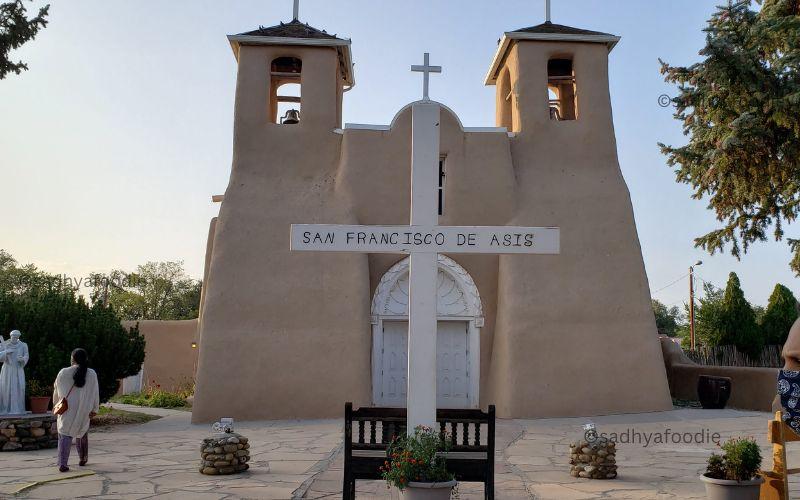
Another must-see stop on the High Road to Taos is the San Francisco de Asis Church in Taos. This iconic church is known for its massive adobe walls and beautiful Southwestern architecture.
The church has been a fixture of the Taos community for centuries, and its history is just as fascinating as its architecture. Legend has it that the famous artist Georgia O’Keeffe even painted a portrait of the church, which is now housed in the permanent collection of the Art Institute of Chicago.
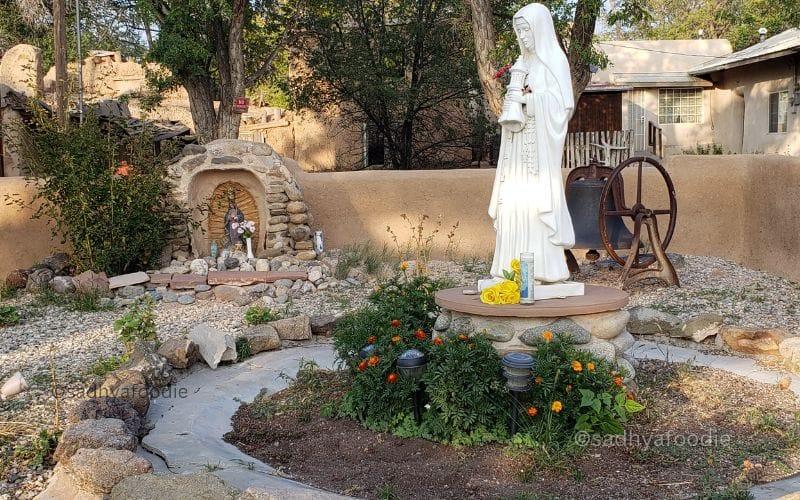
But the San Francisco de Asis Church isn’t just a beautiful landmark – it’s also an important symbol of the area’s cultural heritage. The church has served as a place of worship for the Taos community for over 200 years, and it has played a key role in preserving the region’s rich history and traditions.
And if you’re interested in architecture, be sure to visit the nearby Taos Pueblo, which is a UNESCO World Heritage Site and one of the oldest continuously inhabited communities in North America.
Taos Pueblo UNESCO World Heritage Site
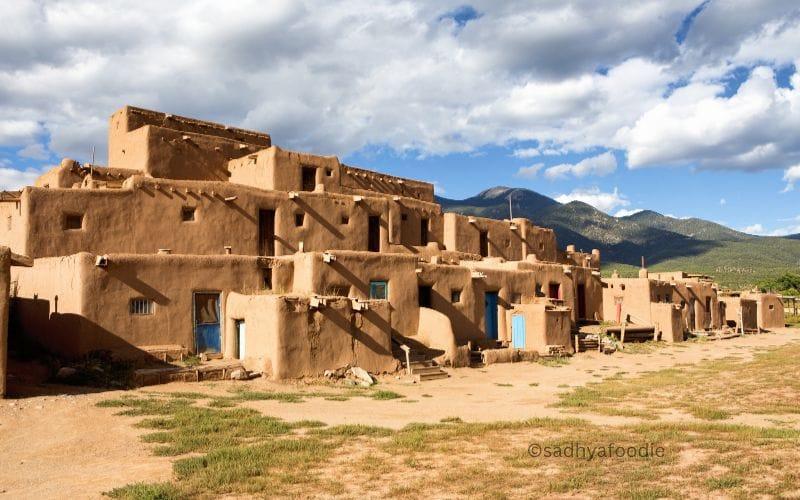
Taos Pueblo is a UNESCO World Heritage Site and is one of the oldest continuously inhabited communities in the United States. The Pueblo is located at the base of the Sangre de Cristo Mountains and is made up of multi-story adobe buildings that have been inhabited for over 1,000 years. Visitors to Pueblo can experience the traditional way of life of the Taos people, including their unique customs, language, and art.
The Pueblo is also home to several annual events and ceremonies that attract visitors from around the world. These events include the Taos Pueblo Powwow, a celebration of Native American dance, music, and culture, and the San Geronimo Feast Day, a traditional celebration of Pueblo’s patron saint. Visitors to Taos Pueblo can also enjoy hiking trails, traditional crafts, and guided tours of the site, making it a must-visit destination for anyone interested in Native American culture and history.
Taos: Culture and Natural Wonders
Your journey along the High Road to Taos Scenic Byway ends in the town of Taos, which is a hub of culture, history, and natural wonders. Taos is home to many museums, galleries, and cultural centers, which offer a glimpse into the region’s rich history and traditions.
One of the top attractions in Taos is the Taos Pueblo, which is a living Native American community that has been inhabited for over 1,000 years. You can take a guided tour of the pueblo and learn about its history and culture, or simply wander through the streets and soak up the atmosphere.
Taos is also a great place to explore the outdoors, with many hiking trails, scenic drives, and natural wonders nearby. Be sure to visit the Rio Grande Gorge, which is a stunning canyon that offers breathtaking views and excellent hiking opportunities.
Rio Grande del Norte National Monument
The Rio Grande del Norte National Monument is a must-see on any road trip from Taos to Santa Fe, New Mexico. It has unusual geological land formations.
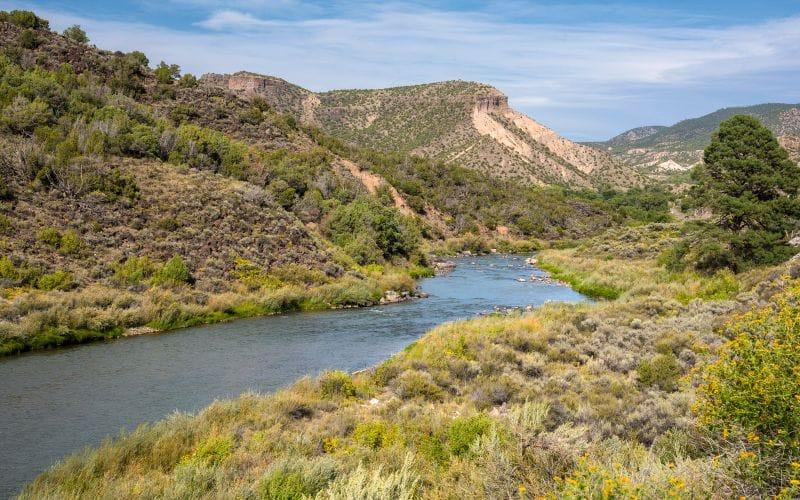
The Enchanted Circle Scenic Byway
If you have more time to explore the region, be sure to check out the Enchanted Circle Scenic Byway, which is an 84-mile loop that takes you through some of the most stunning landscapes in northern New Mexico. This scenic drive takes you through mountain valleys, past pristine lakes, and through charming mountain towns
One of the highlights of the Enchanted Circle Scenic Byway is the ski resort town of Angel Fire, which is a popular destination for winter sports enthusiasts. But even in the summer months, Angel Fire offers plenty of outdoor activities, including hiking, mountain biking, and fishing.
Another must-see attraction on the Enchanted Circle Scenic Byway is the town of Red River, which is a charming mountain town known for its Old West atmosphere and abundance of outdoor activities. You can go horseback riding, fishing, or hiking in the surrounding mountains, or simply wander through the town’s many shops and galleries.
Conclusion
High Road to Taos Scenic Byway is a must-see for anyone visiting New Mexico. This winding route takes you on a journey through some of the most breathtaking landscapes in the state, while providing glimpses into the unique cultural heritage of the region. From traditional Spanish Land Grant and Pueblo Indian villages to the galleries and studios of local artisans, there is something for everyone along the way.




